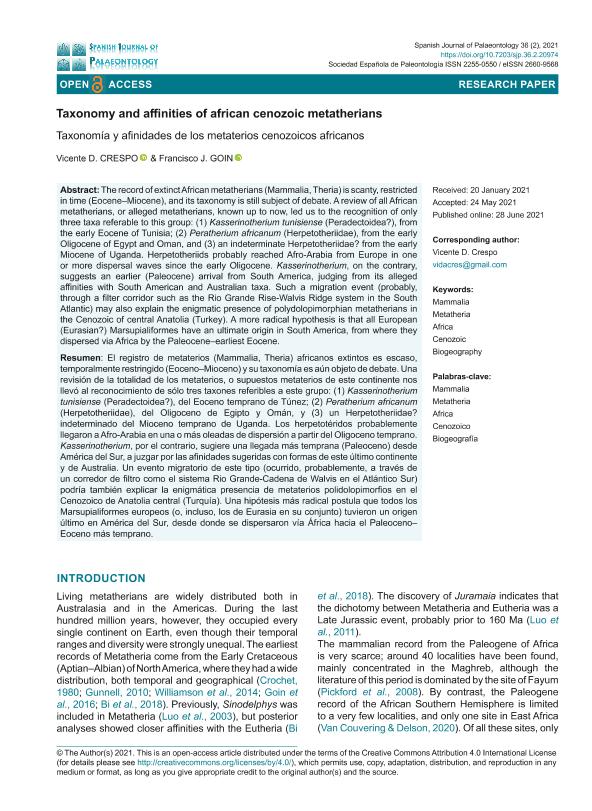Mostrar el registro sencillo del ítem
dc.contributor.author
Crespo Roures, Vicente Daniel

dc.contributor.author
Goin, Francisco Javier

dc.date.available
2022-08-10T16:28:39Z
dc.date.issued
2021-06
dc.identifier.citation
Crespo Roures, Vicente Daniel; Goin, Francisco Javier; Taxonomy and affinities of african cenozoic metatherians; Sociedad Española de Paleontología; Spanish Journal of Palaeontology; 36; 2; 6-2021; 133-148
dc.identifier.issn
2660-9568
dc.identifier.uri
http://hdl.handle.net/11336/165007
dc.description.abstract
The record of extinct African metatherians (Mammalia, Theria) is scanty, restricted in time (Eocene–Miocene), and its taxonomy is still subject of debate. A review of all African metatherians, or alleged metatherians, known up to now, led us to the recognition of only three taxa referable to this group: (1) Kasserinotherium tunisiense (Peradectoidea?), from the early Eocene of Tunisia; (2) Peratherium africanum (Herpetotheriidae), from the early Oligocene of Egypt and Oman, and (3) an indeterminate Herpetotheriidae? from the early Miocene of Uganda. Herpetotheriids probably reached Afro-Arabia from Europe in one or more dispersal waves since the early Oligocene. Kasserinotherium, on the contrary, suggests an earlier (Paleocene) arrival from South America, judging from its alleged affi nities with South American and Australian taxa. Such a migration event (probably, through a fi lter corridor such as the Rio Grande Rise-Walvis Ridge system in the South Atlantic) may also explain the enigmatic presence of polydolopimorphian metatherians in the Cenozoic of central Anatolia (Turkey). A more radical hypothesis is that all European (Eurasian?) Marsupialiformes have an ultimate origin in South America, from where they dispersed via Africa by the Paleocene–earliest Eocene.
dc.description.abstract
El registro de metaterios (Mammalia, Theria) africanos extintos es escaso, temporalmente restringido (Eoceno–Mioceno) y su taxonomía es aún objeto de debate. Una revisión de la totalidad de los metaterios, o supuestos metaterios de este continente nos llevó al reconocimiento de sólo tres taxones referibles a este grupo: (1) Kasserinotherium tunisiense (Peradectoidea?), del Eoceno temprano de Túnez; (2) Peratherium africanum (Herpetotheriidae), del Oligoceno de Egipto y Omán, y (3) un Herpetotheriidae? indeterminado del Mioceno temprano de Uganda. Los herpetotéridos probablemente llegaron a Afro-Arabia en una o más oleadas de dispersión a partir del Oligoceno temprano. Kasserinotherium, por el contrario, sugiere una llegada más temprana (Paleoceno) desde América del Sur, a juzgar por las afi nidades sugeridas con formas de este último continente y de Australia. Un evento migratorio de este tipo (ocurrido, probablemente, a través de un corredor de fi ltro como el sistema Rio Grande-Cadena de Walvis en el Atlántico Sur) podría también explicar la enigmática presencia de metaterios polidolopimorfi os en el Cenozoico de Anatolia central (Turquía). Una hipótesis más radical postula que todos los Marsupialiformes europeos (o, incluso, los de Eurasia en su conjunto) tuvieron un origen último en América del Sur, desde donde se dispersaron vía África hacia el Paleoceno– Eoceno más temprano.
dc.format
application/pdf
dc.language.iso
eng
dc.publisher
Sociedad Española de Paleontología
dc.rights
info:eu-repo/semantics/openAccess
dc.rights.uri
https://creativecommons.org/licenses/by/2.5/ar/
dc.subject
AFRICA
dc.subject
BIOGEOGRAPHY
dc.subject
CENOZOIC
dc.subject
MAMMALIA
dc.subject
METATHERIA
dc.subject.classification
Paleontología

dc.subject.classification
Ciencias de la Tierra y relacionadas con el Medio Ambiente

dc.subject.classification
CIENCIAS NATURALES Y EXACTAS

dc.title
Taxonomy and affinities of african cenozoic metatherians
dc.title
Taxonomía y afinidades de los metaterios cenozoicos africanos
dc.type
info:eu-repo/semantics/article
dc.type
info:ar-repo/semantics/artículo
dc.type
info:eu-repo/semantics/publishedVersion
dc.date.updated
2022-08-03T18:11:32Z
dc.identifier.eissn
2255-0550
dc.journal.volume
36
dc.journal.number
2
dc.journal.pagination
133-148
dc.journal.pais
España

dc.description.fil
Fil: Crespo Roures, Vicente Daniel. Universidad Nacional de La Plata. Facultad de Ciencias Naturales y Museo. División Paleontología Vertebrados; Argentina. Consejo Nacional de Investigaciones Científicas y Técnicas. Centro Científico Tecnológico Conicet - La Plata; Argentina
dc.description.fil
Fil: Goin, Francisco Javier. Universidad Nacional de La Plata. Facultad de Ciencias Naturales y Museo. División Paleontología Vertebrados; Argentina. Consejo Nacional de Investigaciones Científicas y Técnicas. Centro Científico Tecnológico Conicet - La Plata; Argentina
dc.journal.title
Spanish Journal of Palaeontology
dc.relation.alternativeid
info:eu-repo/semantics/altIdentifier/url/https://ojs.uv.es/index.php/sjpalaeontology/article/view/20974
dc.relation.alternativeid
info:eu-repo/semantics/altIdentifier/doi/http://dx.doi.org/10.7203/sjp.36.2.20974
Archivos asociados
